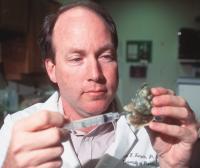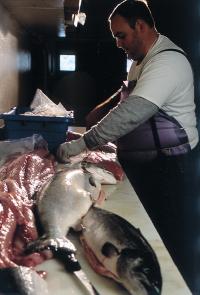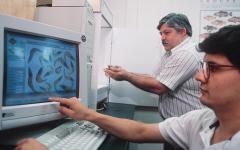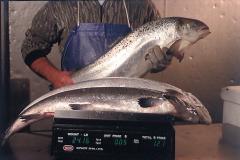|
UF's Institute of Food and Agricultural Sciences works to ensure seafood's safety |
Seafood Safety
by Andrea L. Billups
photography by Gene Bednarek
Floridians love their seafood. A recent study by the University of Florida's Agricultural Market Research Center found that Sunshine State residents consume about 40 pounds per person per year, more than twice the national average.
But studies also suggest that consumers are concerned about seafood safety, especially as outbreaks of illness, and even deaths, from bad seafood are reported in the media. For example, one study showed a dramatic loss of confidence in the safety of oysters. In a 1990 survey, only 9 percent of respondents considered oysters ``not safe at all.'' In a similar survey five years later, that figure had jumped to 31 percent.
For many years, scientists at UF's Institute of Food and Agricultural Sciences have studied ways to improve the safety and quality of all seafood --- not only oysters, but clams, shrimp, fish and a host of other seafood products.
Their research has captured worldwide attention, so much so that
scientists, regulators and commercial seafood executives regularly
travel to Gainesville to learn more about current safety and
processing techniques and ways to improve their own professional
seafood industry standards. And, a new Aquatic Food Products Lab
opening on campus firmly establishes IFAS' future research role (see
sidebar).
Concerns With Shellfish
Recent seafood research at IFAS has looked at ways to detect harmful bacteria often found in seafood. From the Vibrio vulnificus bacteria that lives in raw oysters to salmonella and Listeria that both can thrive in improperly handled fish, scientists look for ways to detect these contaminants, as well as ways to remove them or to keep them from occurring altogether.
|
Mark Tamplin photo by Milt Putnam |
For the past six years, UF home economics Professor Mark Tamplin has studied Vibrio vulnificus in shellfish. Each year, some consumers of Florida shellfish are stricken with an illness caused by the common Vibrio bacteria that thrives in coastal waters. The food safety research program at IFAS' Department of Family, Youth and Community Sciences has found a new and effective way of determining when raw oysters and clams can pose special problems. While the Vibrio bacteria is not usually harmful to most people, it can cause serious problems for people with compromised immune systems --- such as those with liver disease, cancer, AIDS, hemochromatosis and diabetes.
Tamplin has looked at how the bacteria thrives in its natural environment, especially during certain times of the year. In the Gulf of Mexico, prime oyster-harvesting waters, the bacteria lives year round. From April through September, increases in water temperatures cause Vibrio counts to rise. This research has led to new temperature-related harvest criteria that are used by state regulatory agencies and the oyster industry.
IFAS scientists were the first to generate data on the levels of Vibrio vulnificus in oysters and water. They also developed the first model that used a simple temperature-and-salinity equation to predict the levels of Vibrio vulnificus in water.
With this model, ``You can forego a lot of the expensive microbiological tests,'' Tamplin says.
He also says researchers have learned more about different strains of Vibrio bacteria in oysters, leading to a better understanding about the infective dose of which types of bacteria must be consumed to make people ill.
``A single oyster can contain more than 100 strains of Vibrio vulnificus,'' Tamplin says. ``There may be special strains that could provide clues to why some people get sick and others don't.''
Tamplin and his colleagues use a DNA matching technique to determine which types of Vibrio bacteria are dangerous.
This new technique was developed through funding by UF, the Florida departments of health and environmental protection, Florida Sea Grant, the U.S. Department of Agriculture and the National Oceanographic and Atmospheric Administration.
Using the DNA technique, scientists determine how many and which types of Vibrio vulnificus need to be present to pose a health risk. Prior to this finding, it was impossible to know which shellfish could transmit the disease. Based on the results of these studies, Florida's multimillion-dollar shellfish industry now uses new temperature and harvesting safeguards.
Scientists also are looking at strains of Vibrio bacteria present in the blood of someone who has become ill from consuming tainted seafood.
``We're trying to locate the same culprit in the blood that is in the oyster,'' Tamplin says.
This poses a real challenge. With Vibrio poisoning, illness usually is swift and a patient is immediately rushed to the hospital. Scientists often have a hard time pinning down the patient for a blood sample and locating the seafood restaurant to test the batch of oysters the patient ingested.
To help medical professionals understand their research and the crucial time element involved, IFAS scientists will host a satellite teleconference this spring for microbiologists who work in hospitals.
``We want to get to the frontline people who first recognize this illness so they can quickly contact us,'' Tamplin says. ``We need to find the patients, find the oysters and try to find the infective dose.''
Red Tide Rising
For the past two summers, outbreaks of red tide have set back oyster harvesting in the Apalachicola Bay area, as well as posed problems for other Florida fishermen.
Red tide is a toxic algae that has been blamed for massive fish kills and seafood contamination in Florida and all over the world.
Food science and human nutrition Professor Gary Rodrick is looking at the effects of ozone depuration on the toxic red tide algae. Rodrick's research hopes to determine if oysters can be cleaned of the red tide toxins more quickly by flushing them with water that contains ozone, a light gas that is a stronger oxidant than chlorine.
The process works by bathing oysters and shellfish in seawater that has had ozone injected into it. The ozone acts as a disinfectant.
Ozone depuration for shellfish has not yet been approved for use in the United States, but it is used to disinfect drinking water and wastewater. Rodrick and his colleagues have visited Ireland's Bantry Bay where ozone depuration has worked successfully on red tide-infected mussels. In 1997, Rodrick will use the technique on oysters in France and Australia and, eventually, will test it on a future red tide outbreak in Florida.
``We're hoping we will have enough information in the next year so we can get it approved,'' Rodrick says. ``We want to test it in a commercial setting with a red tide outbreak. From our research so far, we've seen dramatic reductions.''
Making Salmon Safer
Although many people may not know it, Miami is home to the largest smoked salmon plant in the United States. Recent federal safety mandates have prompted Rodrick and other IFAS scientists to look for ways to detect bacteria like Listeria that occurs during the cold smoking of salmon.
|
Gary Rodrick researches ways to detect bacteria like Listeria that occur during the cold smoking of salmon. photo by Thomas Wright |
Salmon producers usually smoke the fish with heat or through a process called cold smoking, which involves thawing the salmon; soaking it in a salt, sugar and spice solution in a process called ``brining;'' and then letting the brined fish drip.
Cold smoking, however, often creates problems with Listeria. IFAS scientists are trying to control the Listeria's growth by adding sodium lactate, or lactic acid, to the cold-smoking process.
``We monitored the salmon as it was cold smoked with and without lactic acid to see what happened,'' Rodrick says. ``The lactic acid definitely lowered bacterial levels and inhibited the growth of Listeria.''
Rodrick also monitored Listeria levels in salmon with a rather unusual technique, a light similar to the light of the firefly.
Scientists inserted the lux gene that causes light emission into specific regions of the Listeria bacteria's DNA. Then, they added the Listeria to the salmon after it thawed and continued with the cold-smoking process. To find out if the Listeria bacteria were still present after cold smoking, the scientists just coated the fish with a substance called dodecanal and darkened the room.
``If it glowed, you knew it was producing a toxin,'' Rodrick says. ``This allows us to verify processes.''
Rodrick says use of the light emission gene to detect bacteria in salmon had never been tried by scientists before.
``It's a pretty novel idea,'' he says. ``We want to use it on other foods like poultry, crabmeat and possibly some vegetables. This is really a pretty neat way to see if food processes are effective in killing the bacteria.''
|
Scott Richardson prepares fresh fish at Gainesville's Northwest Seafood. |
The Cost Of Safety
While scientists labor to make seafood safer, the cost of safety may eventually get passed on to consumers.
Research by Professor Robert Degner of IFAS' Department of Food and Resource Economics shows that people may be willing to pay for their peace of mind.
In a study of shellfish consumption by the Florida Agricultural Market Research Center, more than half of those who said they ate oysters said they would pay the extra price for depurated oysters. Depuration is a process of flushing live oysters and clams with purified salt water to reduce the number of bacteria and viruses present in these mollusks. Although depuration will not remove all bacteria and viruses, it is thought to make the shellfish safer.
When told oysters cost on average 50 cents each, 70 percent of those willing to buy depurated oysters said they would pay up to an additional 50 cents each to know they were getting a safer product.
Some restaurant managers also said they would pay for safety and buy depurated oysters and clams. According to Degner's study, the restaurant managers' primary motivation would be to reduce their legal liability in the event a customer became ill. However, better quantitative data are needed to convince restaurants, and, more importantly, their insurance underwriters, that depuration results in a safe, wholesome product, the study found.
``Consumer confidence in shellfish safety has greatly deteriorated during the past few years. Frequent, adverse media coverage of seafood-borne illness, coupled with consumption advisory notices issued by health officials, have undermined public confidence,'' Degner says. ``But the promise of safer oysters and clams has a broad-based appeal, and consumers appear willing to pay the costs associated with the depuration process.''
Shrimp Scanner
Shrimp eaten by the nation's consumers may soon be safer and of higher quality as a new system developed and tested by a UF researcher becomes available to the seafood industry.
|
Murat Balaban, associate professor of food engineering, feeds raw shrimp into a scanner that uses an automated computer program to objectively evaluate the quality of shrimp. photo by Thomas Wright |
Murat Balaban, associate professor of food engineering, is testing an automated computer program that determines the quality of shrimp. Balaban says the system objectively evaluates shrimp quality and may serve as a valuable tool for seafood inspectors and processors.
``An objective, repeatable measurement of quality is necessary because quality is directly related to safety in seafood,'' Balaban says. ``The quality of shrimp now can be assured through calculated and repeatable data.''
The system, developed by Balaban and IFAS colleagues in industrial and systems engineering, automatically analyzes three criteria for freshness in shrimp: appearance, ammonia level, and texture and elasticity.
A batch of shrimp is placed into a light box, photographed and displayed on a computer screen. The individual shrimp and any foreign objects are identified, and then the program analyzes the batch for presence of black spots (or melanosis) and color range of the shrimp. The number of shrimp per pound also is calculated.
An electrode is used to measure the level of ammonia, an indicator of shrimp freshness. The shrimp are then funneled through a squeezing device that tests for texture and elasticity. All the criteria are evaluated in about four minutes.
A score for each of the three criteria is assigned along with an
overall rating of batch quality. The program allows the batch to be
accepted or rejected, and a complete set of information about the
sample is stored in a database for future reference.
|
Floridians love their seafood. A recent study by the University of Florida's Agricultural Market Research Center found that Sunshine State residents consume about 40 pounds per person per year, more than twice the national average. |
Balaban says 90 percent of the shrimp caught in the United States comes from the Southeast, particularly Florida, Alabama and Louisiana. And since half of the shrimp imported into the United States enters through the Port of Miami, the quality and safety of shrimp also have economic implications for the state.
International standards for measuring shrimp quality are important because about 70 percent of the shrimp processed each year in the United States is imported, Balaban says. The automated system will help U.S. inspectors confirm their evaluations of imported shrimp.
``This automated device will be a tremendous help in evaluating and regulating worldwide standards for quality and safety of shrimp,'' Balaban says. ``The analysis for a batch of shrimp should have an objective and consistent reading no matter where the evaluation is made.''
Seafood regulators and industry processors should be glad to see an objective system for measuring shrimp quality, says James Cato, director of Florida Sea Grant, which funded the project. Cato says IFAS researchers were able to work with the seafood industry to achieve a science-based, cost-effective, automated evaluation of shrimp quality.
``Because shrimp is traded worldwide, acceptable quality and safety standards are vital,'' Cato says. ``It is important for the university to provide the science for streamlining a device that is acceptable to everyone involved in the industry.''
Balaban says consumers will be the big winners.
``Consumer safety no longer has to be compromised when it comes to shrimp,'' he says. ``With this system in place, consumers will be guaranteed to get exactly what they pay for --- good-quality shrimp.''
Mark Tamplin
Associate Professor, Department of Family, Youth and Community Sciences,
(352) 392-2030,
mlt@gnv.ifas.ufl.edu
Gary Rodrick
Professor, Department of Food Science and Human Nutrition,
(352) 392-8001,
ger@gnv.ifas.ufl.edu
Robert Degner
Director, Florida Agricultural Market Research Center,
(352) 392-1871,
fredrld@nervm.nerdc.ufl.edu
Murat Balaban
Associate Professor, Department of Food Science and Human Nutrition,
(352) 392-4273,
mob@gnv.ifas.ufl.edu
|
A q u a t i c F o o d P r o d u c t s L a b |
photo illustration by Thomas Wright Laboratory is "Home Port" for Seafood SafetyThe University of Florida is now home to an international center for research and training in seafood safety issues. With the completion of the Aquatic Food Products Laboratory on campus in January, the university has a state-of-the-art facility for conducting research and teaching, and for assisting seafood professionals from around the world. ''This lab truly serves as a center for cooperative work between the university, industry and government,'' says Steve Otwell, a Florida Sea Grant seafood technology specialist and one of the leaders in securing funding for the lab. Industry support for the new lab has been enormous. More than 40 firms and individuals contributed in excess of $800,000 toward the lab's construction. Matching funds of $830,000, provided by the Florida Legislature, brought the budget to more than $1.6 million. The Florida Sea Grant College Program also played a key role in securing donations for the lab. Sea Grant, headquartered on campus in Gainesville, has made seafood safety and quality a priority for nearly 20 years. This commitment coupled with the commitment of industry and government underscores the message that research, education and cooperation provided by the lab are paramount to meeting the needs of both industry and consumers. In addition to programs that involve students, the lab will serve as a key facility in providing HACCP training for seafood processors nationally and internationally. HACCP is an acronym for Hazard Analysis of Critical Control Points, and part of a federal regulatory program adopted by the Food and Drug Administration. HACCP will work as an effective and efficient preventative system that seafood processors can use to ensure the safety of their products for consumers. To help industry implement new HACCP regulations, the National Sea Grant Program has developed a nationwide training program, with the Florida Sea Grant Program leading the training effort. Florida Sea Grant will develop and maintain a Seafood and Aquaculture HACCP Training School at the new lab which will provide training in HACCP compliance for both international and domestic companies involved in temperate and tropical aquatic food products. |






